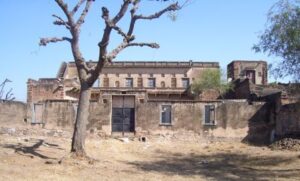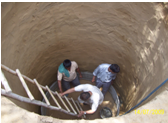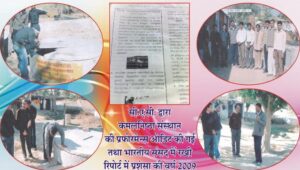Rooftop Rainwater Harvesting
The Dissemination of Rooftop water Harvesting in the Drought Prone Areas of Rajasthan
Duration: 01-04-2009 to 30-06-2010.
Funding Agency: Council of Advancement of People’s Action and Rural Technology (CAPART), Ministry of Rural Development.
 Being a part of the Thar Desert, Jhunjhunu district of Rajasthan is characterized by dry climate with large variation in temperature and rainfall. The desert areas in Jhunjhunu have been very badly affected by the situation of serious drought and famine in almost every alternate year. People have faced a series of famine in the period from 1998 to 2002 continually and after that also alternatively in the block of Nawalgarh and Udaipurwati. Primary sources of livelihood here are agriculture and animal farming which ultimately rely on rain. The main sources of irrigation and drinking water are wells and bore-wells which are proving to be insufficient now.
Being a part of the Thar Desert, Jhunjhunu district of Rajasthan is characterized by dry climate with large variation in temperature and rainfall. The desert areas in Jhunjhunu have been very badly affected by the situation of serious drought and famine in almost every alternate year. People have faced a series of famine in the period from 1998 to 2002 continually and after that also alternatively in the block of Nawalgarh and Udaipurwati. Primary sources of livelihood here are agriculture and animal farming which ultimately rely on rain. The main sources of irrigation and drinking water are wells and bore-wells which are proving to be insufficient now.
The rain water is available for more than four months during the monsoon seasons. The available water was enough for the population till last two decades but due to increase in the population and over exploitation of groundwater, the available water is proving to be insufficient. During summer bore wells dry out. In addition, the existing tanks and ponds are not maintained properly for decades. The tanks, dams (Kot-dam, Makkhan-Dass dam, Mansa-Mata Dam to name few) are not de-silted for a long period and the bunds eventually dwindled. The rainfall in the district has been decreasing to some extent for the last two decades and the capacity of existing tanks and bunds to preserve have substantially decreased. Almost all the open wells in the district have been abandoned due to non-availability of water. Due to continuous exploitation of ground water, lack of rain and sands storms the water table has descended drastically. Government is trying hard to at least meet the drinking requirement of the people. This situation is leading to a scary future. It’s high time that the people need to be guided and taught rain water harvesting to store rain water and use it throughout the year, thus reduce the dependence on the ground water sources.
Area of implementation: The project areas taken up by the organisation are 7 Villages of Nawalgarh and Udaipurwati Panchayat Samiti of Jhunjhunu district namely Basawa, Bay, Kolsia, Majhau, Parsampura, Raghunathpura, Singnore.
Objectives:
- 1. To introduce and popularize the technology of roof top water harvesting among the people in general and poor people in particular.
- 2. To help the poor and needy people to install roof top water harvesting system in their houses.
- 3. To ensure reduction of use of ground water through bore wells to maintain the water table in the area.
- 4. To train women from self help groups to motivate the people about the importance of roof top water harvesting scheme.
Operations/ Execution:
- 1. Awareness-cum exposure visit organized at villages to introduce and popularize the technology of roof top water harvesting among the people.
- 2. Organized meeting and cultural programmes explaining the technology of roof top water harvesting.
- 3. Constructed Roof top water harvesting structure using with ferro-cement technology in houses of 100 beneficiaries in the target area.
- 4. Ownership of the constructed Tankas was transferred to the beneficiaries.
Outcome: The project has impact on community directly and indirectly.
- 1. The beneficiaries say that the major problem regarding potable
water has been solved as tapped rain water is cleanest among all source of water. Earlier they used to bring drinking water from a distance and that activity consumed lot of time, and labor.

Work done by the Kamalnishtha Sansthan was praised by CAG in the Parliament
- 2. Secondly up gradation of the socio-condition happening as the neighbours also uses the water from the constructed Tankas thus promoting the brotherhood feeling. Reduction in use of ground-water through bore wells and thus helps in maintaining the water table.
- 3. Execution of project in 7 different villages instead of single village has motivated people on large scale to adopt RWH.
Recognition: Comptroller and Auditor General of India (CAG) audited the performance of the said project undertaken by Kamalnishtha Sansthan and praised the same in the parliament.